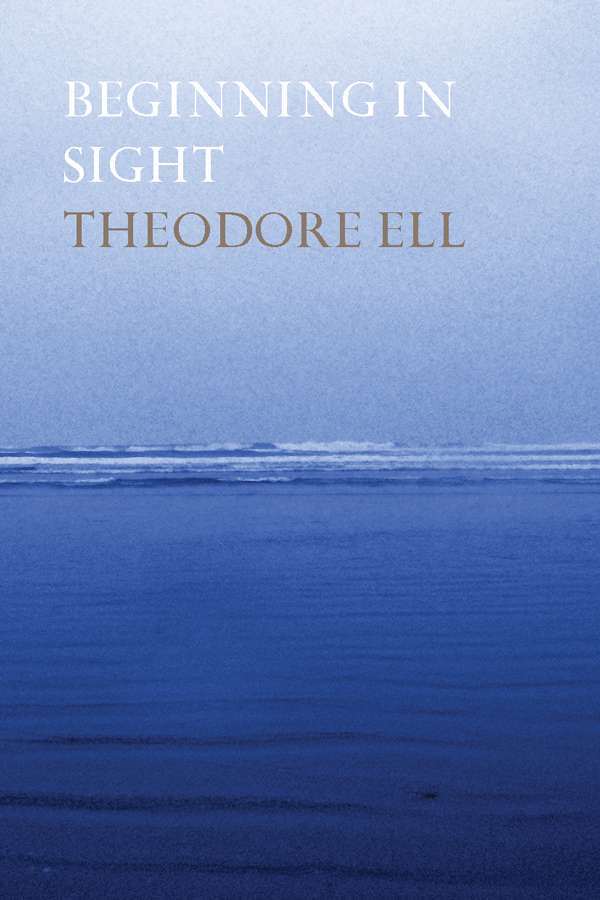
 Natural Philosophies by Michael J. Leach
Natural Philosophies by Michael J. Leach
Recent Work Press, 2022
Beginning in Sight by Theodore Ell
Recent Work Press, 2022
Published by Recent Work Press in 2022, the following two debut collections of poetry I’ve had the pleasure of spending time with are both stylistically and gestationally distinct from one another. Natural Philosophies by Michael J. Leach is an eclectic mixture of poetic experiments that nobly attempt to marry science and medicine with art and poetics. Theodore Ell’s Beginning in Sight, gracefully vintaged in its composition and heavily focused on the primacy of the visual, is a haunting and considered meditation on time as it unfolds beneath the eye.
Natural Philosophies is Michael J. Leach’s debut full-length collection of poetry, and emanates the excitement and enthusiasm of a poet who has, in discovering musical instruments, not only taken up learning the piano but the guitar, oboe, trumpet, flute, and marimba. While the themes of Leach’s book revolve mainly around the intersection of health-related bioscience and poetics – in particular applying his pharmacoepidemiological background to this encounter – the poetic forms he employs in the treatment of his subject-matter are diverse and eclectic. The pleasure which Leach takes in exploring such a variety of instruments is the central joy of this book – from concrete poems, ekphrasis, a villanelle, a variety of ekphrastic poems, and several variations of the acrostic to dual-stanza poems and sets of haiku. It is easy to tell that Leach is having abundant fun, which in its own way is deeply refreshing to witness. Leach has great empathy for readers who identify with feeling alienated by the use of specialised language and goes to great lengths to cater for his audience. The medical, pharmaceutical, and health-system lexicon Leach employs in many of his poems attempts to cushion language that can be difficult to navigate and discern as non-doctors.
While it is of course common for volumes of poetry to contain notes on their poems to acknowledge intertextual references, obscure terminology etc., Leach’s ‘Notes’ section contains an 8-page appendix that offers at times a play-by-play break down of more or less every poem in the book. With this exhaustive reference section Leach is more or less offering to do all the work a curious and enthusiastic close-reader would otherwise have taken pleasure in doing for themselves. Perhaps this is due to Leach’s concern that these poems may be overly strenuous for the target audience to interpret, or perhaps the concern is that they may be ‘asymptomatically’ read by some kind of ‘free-reader’ out there who Leach is worried may not uncover the ‘right’ mandible/cranium/femur when they do not fervently excavate for his true intention. Leach politely assists us in our efforts, freely or unfreely, to understand what he has decided is happening in his poems and, for example, which Bass Strait Leach he is referring to in his concrete wave-poem ‘Back to the sea’ when he describes “salty, curvaceous waves direct from Bass Strait” (the one north of Tassie FYI) (30).
Leach does not leave us stranded and alone with poems such as ‘Frida Kahlo’s Backbone,’ which before reading Leach’s notes, I could only assume was the miraculous ekphrastic discernment of the meat of Kahlo’s biography from her 1944 painting The Broken Column.
Frida Kahlo was born in July, 1907 in old Coyoacán, Mexico. She was six years old going on 47 when polio struck her down. She survived with a shrivelled leg and threw herself into sports. Proud parents stoked the bright fire of young Frida’s quick mind. At 18, Frida was in a motor car crash that fractured her to pieces. Though she was lucky to be alive, her life goals burned to ash. Frida went from aspiring doctor to patient trapped in body casts. (36)
While the poem is positioned as an ekphrastic response, it seems more like a chronologically ordered recount of important events in the painter’s life, embellished by a kind of Wikipedia format. The poem captures (according to Leach in his notes) the overlap between health and the arts that Kahlo’s paintings reflect. Perhaps Leach did indeed garner Kahlo’s biography purely from her self-portrait… in which case the poem is very impressive. Enthusiastic about concrete poetics, Leach page-centres the poem to emulate the appearance of a spine – a device he, again, faithfully lets us know about in his notes. As has become evident, Leach has made the job of reviewing the book at all somewhat difficult given that the books’ potential readers are able to garner more or less all the information I am passing onto them about Leach’s poems from Leach’s own handily attached notes. In this sense, the book has been self-reviewed, or self-treated, in advance, as it were. Leach provides a service for those readers confused by the symptoms of their reading and unable to address what perhaps has caused them to read the book in the first instance. We are left to feel a little like the patient with type 2 diabetes that Leach describes in his poem ‘The Second Type’ to whom the following line is addressed after being told to exercise and eat better; “I hand you a booklet while you stare at me” (45). Leach’s attached how-to booklet on his poems, unlike the one handed to his patient, does the ‘exercise’ of reading the poems for us, when presumably many poetry readers would prefer the exercise of interpreting these poems for themselves.
Leach’s poetry in this collection is at its strongest when it is most simple and least explained. A moving example is the closing poem of the book titled ‘Maternal Memories’ which explores the grief of Leach’s loss of his mother under the deeply estranged and emotionally abstract circumstances of the pandemic:
During this rare moment with my baby sister, I look her in the face – lacrimal secretions in familiar eyes reflect mine as we draw ever closer to our final destination. Here I am – an off-duty statistician wholeheartedly believing in the beautiful spirituality of synchronicity. (63)
The only note Leach leaves us for this poem is a concise definition of the acronym DNA, as the rest of the poem rather poignantly needs no explanation – indeed it speaks for itself and Leach seems to be cognisant of this. Whatever allowed Leach to be confident enough to let this poem speak for itself is hopefully where we will see his poetic practice travel to next.









